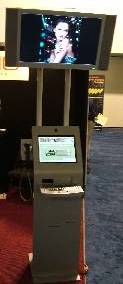News
A kiosk that pays for itself
July 21, 2005
Putting a kiosk in your retail space can bring unique benefits. Depending on what the kiosk is designed to do, it might increase foot traffic, encourage higher same-store purchases, build a database of customer information, allow customers to monitor redemption and loyalty programs, dispense products and services, or it might do all of the above.
Better still is a situation where the kiosk literally pays for itself. Many retailers are turning kiosks into vehicles for POS advertising.
 This story and all the great free content on KioskMarketplace is supported by:  |
The Canadian company Alpha Multimedia has had success with this method. The company installs kiosks in coffee shops and on campuses where the machines offer Internet access, VoIP telephony and video games. Utilizing KING's dual-screen Plynth G5 model, Alpha sells ad space on the top monitor while providing the interactive functionality on the bottom.
"People are very receptive, and like the looks of the kiosks," said Mark Singh, regional sales manager for Alpha Multimedia.
 |
According to Singh, 90 percent of the advertising inventory on the screens is currently sold. The company has 50 such kiosks deployed at the moment, but are preparing to purchase an additional 300 - which, of course, opens up that much more ad inventory.
"The pay-per-use public Internet model is not viable on its own, except perhaps in an airport environment," Giblett said.
"The business models that seem to be working today are kiosks that provide additional services Â… plus the addition of an advertising component." Such services include "dispensing prepaid long distance cards, cellular top-up, printing coupons for nearby restaurants, bars and attractions, even online games where users win instant prizes from local sponsors, as well as kiosks that provide a wireless hot spot."
Giblett said the Plynth is customizable so the retailer can choose just how much of an impact they want their ads to make. The base model includes an 18-inch display on top, but he said that display could be made as large as 37 inches.
Retailers can also take advantage of advanced software tools that manage the ad content. For instance, a store that has heavy teen traffic during after-school hours might want to push ads aimed at that age group during that time. The weeks before major holidays lend themselves to creative ad scheduling, as do local events, loyalty program offerings and weekly specials.
"Our Advertising Scheduling application makes it easy for the operator to display ads based on time-of-day, day-of-week or even event-based," Giblett said.











